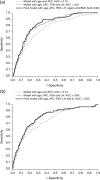Prognostic models for high and low ovarian responses in controlled ovarian stimulation using a GnRH antagonist protocol
- PMID: 24903202
- PMCID: PMC4093990
- DOI: 10.1093/humrep/deu090
Prognostic models for high and low ovarian responses in controlled ovarian stimulation using a GnRH antagonist protocol
Abstract
Study question: Can predictors of low and high ovarian responses be identified in patients undergoing controlled ovarian stimulation (COS) in a GnRH antagonist protocol?
Summary answer: Common prognostic factors for high and low ovarian responses were female age, antral follicle count (AFC) and basal serum FSH and LH.
What is known already: Predictors of ovarian response have been identified in GnRH agonist protocols. With the introduction of GnRH antagonists to prevent premature LH rises during COS, and the gradual shift in use of long GnRH agonist to short GnRH antagonist protocols, there is a need for data on the predictability of ovarian response in GnRH antagonist cycles.
Study design, size, duration: A retrospective analysis of data from the Engage trial and validation with the Xpect trial. Prognostic models were constructed for high (>18 oocytes retrieved) and low (<6 oocytes retrieved) ovarian response. Model building was based on the recombinant FSH (rFSH) arm (n = 747) of the Engage trial. Multivariable logistic regression models were constructed in a stepwise fashion (P < 0.15 for entry). Validation based on calibration was performed in patients with equivalent treatment (n = 199) in the Xpect trial.
Participants/materials, setting, methods: Infertile women with an indication for COS prior to IVF. The Engage and Xpect trials included patients of similar ethnic origins from North America and Europe who had regular menstrual cycles. The main causes of infertility were male factor, tubal factor and endometriosis.
Main results and the role of chance: In the Engage trial, 18.3% of patients had a high and 12.7% had a low ovarian response. Age, AFC, serum FSH and serum LH at stimulation Day 1 were prognostic for both high and low ovarian responses. Higher AFC and LH were associated with an increased chance of high ovarian response. Older age and higher FSH correlated with an increased chance of low ovarian response. Region (North America/Europe) and BMI were prognostic for high ovarian response, and serum estradiol at stimulation Day 1 was associated with low ovarian response. The area under the receiver operating characteristic (ROC) curve (AUC) for the model for a high ovarian response was 0.82. Sensitivity and specificity were 0.82 and 0.73; positive and negative predictive values were 0.40 and 0.95, respectively. The AUC for the model for a low ovarian response was 0.80. Sensitivity and specificity were 0.77 and 0.73, respectively; positive and negative predictive values were 0.29 and 0.96, respectively. In Xpect, 19.1% of patients were high ovarian responders and 16.1% were low ovarian responders. The slope of the calibration line was 0.81 and 1.35 for high and low ovarian responses, respectively, both not statistically different from 1.0. In summary, common prognostic factors for high and low ovarian responses were female age, AFC and basal serum FSH and LH. Simple multivariable models are presented that are able to predict both a too low or too high ovarian response in patients treated with a GnRH antagonist protocol and daily rFSH.
Limitations, reasons for caution: Anti-Müllerian hormone was not included in the prediction modelling.
Wider implications of the findings: The findings will help with the identification of patients at risk of a too high or too low ovarian response and individualization of COS treatment.
Study funding/competing interests: Financial support for this study and the editorial work was provided by Merck, Sharp & Dohme Corp. (MSD), a subsidiary of Merck & Co. Inc., Whitehouse Station, NJ, USA. F.J.B. received a grant from CVZ to his institution; P.J.M.V. and H.W. are employees of MSD, and B.M.J.L.M. was an employee of MSD at the time of development of this manuscript.
Trial registration numbers: NCT 00696800 and NCT00778999.
Trial registration: ClinicalTrials.gov NCT00696800 NCT00778999.
Keywords: GnRH antagonist; ovarian response; predictive modelling; recombinant FSH.
© The Author 2014. Published by Oxford University Press on behalf of the European Society of Human Reproduction and Embryology.
Figures


References
-
- Al-Inany HG, Youssef MA, Aboulghar M, Broekmans F, Sterrenburg M, Smit J, Abou-Setta AM. Gonadotrophin-releasing hormone antagonists for assisted reproductive technology. Cochrane Database Syst Rev. 2011:CD001750. - PubMed
-
- Altman DG, Royston P. What do we mean by validating a prognostic model? Stat Med. 2000;19:453–473. - PubMed
-
- Broekmans FJ, Kwee J, Hendriks DJ, Mol BW, Lambalk CB. A systematic review of tests predicting ovarian reserve and IVF outcome. Hum Reprod Update. 2006;12:685–718. - PubMed
-
- Broer SL, Mol BW, Hendriks D, Broekmans FJ. The role of antimullerian hormone in prediction of outcome after IVF: comparison with the antral follicle count. Fertil Steril. 2009;91:705–714. - PubMed
-
- Broer SL, Dolleman M, Opmeer BC, Fauser BC, Mol BW, Broekmans FJ. AMH and AFC as predictors of excessive response in controlled ovarian hyperstimulation: a meta-analysis. Hum Reprod Update. 2011;17:46–54. - PubMed
Publication types
MeSH terms
Substances
Associated data
LinkOut - more resources
Full Text Sources
Other Literature Sources
Medical
Research Materials

